Related Research Articles
The Anatomical Therapeutic Chemical (ATC) Classification System is a drug classification system that classifies the active ingredients of drugs according to the organ or system on which they act and their therapeutic, pharmacological and chemical properties. It is controlled by the World Health Organization Collaborating Centre for Drug Statistics Methodology (WHOCC), and was first published in 1976.

Xylometazoline, also spelled xylomethazoline, is a medication used to reduce symptoms of nasal congestion, allergic rhinitis, and sinusitis. Use is not recommended for more than seven days. Use is also not recommended in those less than three months of age and some say not less than 6 years of age. It is used directly in the nose as a spray or drops.

Filgrastim, sold under the brand name Neupogen among others, is a medication used to treat low neutrophil count. Low neutrophil counts may occur with HIV/AIDS, following chemotherapy or radiation poisoning, or be of an unknown cause. It may also be used to increase white blood cells for gathering during leukapheresis. It is given either by injection into a vein or under the skin.

Mesna, sold under the brand name Mesnex among others, is a medication used in those taking cyclophosphamide or ifosfamide to decrease the risk of bleeding from the bladder. It is used either by mouth or injection into a vein.
Alteplase (t-PA) is a thrombolytic medication, used to treat acute ST elevation myocardial infarction, pulmonary embolism associated with low blood pressure, acute ischemic stroke, and blocked central venous access devices (CVAD). It is given by injection into a vein or artery.
An essential medicines policy is one that aims at ensuring that people get good quality drugs at the lowest possible price, and that doctors prescribe the minimum of required drugs in order to treat the patient's illness. The pioneers in this field were Sri Lanka and Chile.
The defined daily dose (DDD) is a statistical measure of drug consumption, defined by the World Health Organization (WHO) Collaborating Centre for Drug Statistics Methodology. It is defined in combination with the ATC Code drug classification system for grouping related drugs. The DDD enables comparison of drug usage between different drugs in the same group or between different health care environments, or to look at trends in drug utilisation over time. The DDD is not to be confused with the therapeutic dose or Prescribed Daily Dose (PDD), or Recorded Daily Dose (RDD), and will often be different to the dose actually prescribed by a physician for an individual person.

Ifosfamide (IFO), sold under the brand name Ifex among others, is a chemotherapy medication used to treat a number of types of cancer. This includes testicular cancer, soft tissue sarcoma, osteosarcoma, bladder cancer, small cell lung cancer, cervical cancer, and ovarian cancer. It is administered by injection into a vein.
Rifampicin/isoniazid/pyrazinamide, also known as rifampin/isoniazid/pyrazinamide, is a medication used to treat tuberculosis. It is a fixed dose combination of rifampicin, isoniazid, and pyrazinamide. It is used either by itself or along with other antituberculosis medication. It is taken by mouth.
Artemether/lumefantrine, sold under the trade name Coartem among others, is a combination of the two medications artemether and lumefantrine. It is used to treat malaria caused by Plasmodium falciparum that is not treatable with chloroquine. It is not typically used to prevent malaria. It is taken by mouth.

Efavirenz/emtricitabine/tenofovir, sold under the trade name Atripla among others, is a medication used to treat HIV/AIDS. It is a fixed-dose combination of efavirenz, emtricitabine, and tenofovir disoproxil. It can be used by itself or together with other antiretroviral medications. It is taken by mouth once a day.

Dasatinib, sold under the brand name Sprycel, is a targeted therapy used to treat certain cases of chronic myelogenous leukemia (CML) and acute lymphoblastic leukemia (ALL). Specifically it is used to treat cases that are Philadelphia chromosome-positive (Ph+). It is taken by mouth.
Medication costs, also known as drug costs are a common health care cost for many people and health care systems. Prescription costs are the costs to the end consumer. Medication costs are influenced by multiple factors such as patents, stakeholder influence, and marketing expenses. A number of countries including Canada, parts of Europe, and Brasil use external reference pricing as a means to compare drug prices and to determine a base price for a particular medication.

Benzathine benzylpenicillin, also known as benzathine penicillin G, is an antibiotic useful for the treatment of a number of bacterial infections. Specifically it is to treat strep throat, diphtheria, syphilis, and yaws. It is also used to prevent rheumatic fever. It is given by injection into a muscle.
Procaine benzylpenicillin also known as penicillin G procaine, is an antibiotic useful for the treatment of a number of bacterial infections. Specifically it is used for syphilis, anthrax, mouth infections, pneumonia, diphtheria, cellulitis, and animal bites. It is given by injection into a muscle.

Lopinavir/ritonavir (LPV/r), sold under the brand name Kaletra among others, is a fixed dose combination medication for the treatment and prevention of HIV/AIDS. It combines lopinavir with a low dose of ritonavir. It is generally recommended for use with other antiretrovirals. It may be used for prevention after a needlestick injury or other potential exposure. It is taken by mouth as a tablet, capsule, or solution.
EMDEX is the most commonly used reference source of drug and therapeutic information by healthcare professionals in Nigeria. It was first published in 1991 as Nigeria's Essential Drugs (NED) Guide.
EMDEX drug information contents, arrangements and therapeutic recommendations are supported by several references and clinical guidelines notably WHO Model Formulary, WHO ATC Classification System, Nigeria's Essential Medicines List and Standard Treatment Guidelines, etc. The information is regularly reviewed and updated by a select team of healthcare practitioners and academics.
The central objective of EMDEX has been to promote rational use of medicines through provision of independent drug information, and use of clinical guidelines and essential medicines list. It is the largest and up-to-date source of information on drug products approved for use in Nigeria by NAFDAC .
The use of EMDEX as a reference drug manual is endorsed by Pharmacists Council of Nigeria, Nursing & Midwifery Council of Nigeria and major health institutions. It is used both within and outside Nigeria by physicians, dentists, pharmacists, nurse practitioners, and auxiliary health workers at all levels of healthcare delivery. These healthcare providers rely on EMDEX for accuracy and completeness of drug information namely indications, contra-indications, precautions or warnings, adverse effects, dosages, and drug use in special populations like children, elderly, pregnancy & lactation.
EMDEX publications are also in the syllabus of various colleges & schools of medicine, pharmacy & nursing.

Fluorescein is used to help in the diagnosis of a number of eye problems. When applied as a drop or within a strip of paper to the surface of the eye it is used to help detect eye injuries such as foreign bodies and corneal abrasions. When given by mouth or injection into a vein it is used to help evaluate the blood vessels in the back of the eye during fluorescein angiography.
External reference pricing (ERP), also known as international reference pricing, is the practice of regulating the price of a medication in one country, by comparing with the price in a "basket" of other reference countries. It contrasts with internal reference pricing, where the price of one drug is compared to the domestic price of therapeutically related drugs, and with cost-plus pricing, where the price involves negotiating an acceptable markup to the unit cost to develop and produce.
The WHO/Health Action International Project on Medicine Prices and Availability was a partnership between the World Health Organization and Health Action International. It developed a system and methodology for measuring the price, availability and affordability of medicines. The project surveyed over 50 countries. It also created guidance for low-and-middle-income countries to help their governments and associated health organisations to implement policies on drug prices.
References
- 1 2 World Health Organization (2003). The selection and use of essential medicines : report of the WHO Expert Committee, 2002 : (including the 12th model list of essential medicines). Geneva: World Health Organization. hdl: 10665/42620 . ISBN 9241209143. ISSN 0512-3054. WHO technical report series;914.
- 1 2 Vogler, Sabine (2018). Medicine Price Surveys, Analyses and Comparisons: Evidence and Methodology Guidance. Academic Press. p. 220. ISBN 978-0-12-813212-8.
- ↑ Raju, Priyanka Konduru Subramani (2019). "Chapter 6.2 - WHO/HAI Methodology for Measuring Medicine Prices, Availability and Affordability, and Price Components". Medicine Price Surveys, Analyses and Comparisons (Monograph). Academic Press. pp. 209–228. ISBN 978-0-12-813166-4 . Retrieved 27 November 2019.:220
- ↑ "Drug Search Page". International Medical Products Price Guide. Retrieved 4 January 2020.
- 1 2 3 "Price Sources". International Medical Products Price Guide. Retrieved 5 January 2020.
- 1 2 3 4 "Measuring medicine prices, availability, affordability and price components" (PDF). WHO.
- ↑ "How prices were calculated". International Medical Products Price Guide. Retrieved 5 January 2020.
- ↑ Saeed, Amna; Li, Zongjie; Kabba, John Alimamy; Yang, Caijun; Fang, Yu (2019). "External Reference Pricing and Medicines". Encyclopedia of Pharmacy Practice and Clinical Pharmacy. Academic Press. ISBN 978-0-12-812736-0.
- ↑ "ATC/DDD". International Medical Products Price Guide. Retrieved 5 January 2020.
- ↑ "Use of ATC/DDD". WHO. Retrieved 5 January 2020.